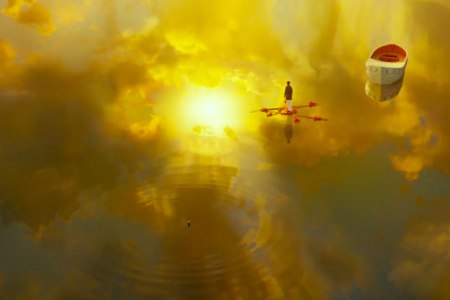Life of Pi: A Review
Life of Pi – Dir: Ang Lee; *ing: Suraj Sharma, Irrfan Khan, Tabu, Rafe Spall, Ayush Tandon, Shravanthi Sainath
Tiger Balm
12 year old Piscine Molitor ‘Pi’ Patel (Tandon) is curious about God. When dared to go and partake of the holy water basin at the local church, he is apprehensive but also giddy at the prospect. As he fulfills the challenge, he catches the attention of the kindly padre in charge who says sympathetically, “You must be thirsty.” For the keen observer, this simple line of dialogue holds the key to the mystery that Life of Pi presents towards the end, the answer to which isn’t as important as perhaps simply asking oneself: which of two versions of a narrated truth is easier to comprehend and accept, and is it fruitful to look for meaning in either?
Yann Martel’s Booker-winning novel has long been touted as being unfilmable; indeed many an acclaimed filmmaker grappled with it before throwing in the towel – Alfonso Cuarón and Jean Pierre Jeunet chief among them. It is possibly no coincidence that both are non-Americans, as is Ang Lee, who finally landed the gig and persevered. For the story is one that requires an outsider’s sensibility or, to be gauchely obvious, someone ‘at sea’ in an unfamiliar world. No stranger to literary adaptations for the screen, Lee is nonetheless in a unique situation here: a Taiwanese filmmaker adapting a book by a French-Canadian author, about an Indian boy from the former French colonial town of Pondicherry in Tamil Nadu, India. Sounds improbable but in fact it turns out to be a stroke of genius, for Lee possesses the vision and chops to not only translate David Magee’s minimalist screenplay into a sensitive, nuanced screen story, but also to use the film’s 3D format, rather like Scorsese’s Hugo last year, to add another narrative dimension to the proceedings. Lee’s deployment of the format doesn’t endlessly and pointlessly throw pointy objects at the audience to justify itself; it instead creates a dazzling array of breathtaking images that are nevertheless there to serve story and character, not to detract from them.
The film opens with a framing device wherein a writer (Spall) has come to the adult Pi (Khan) seeking inspiration for a book. Pi tells him the unlikely but enchanting tale of how he got his unusual name, and how he fought to change it to the comparatively more respectable and enigmatic Pi when being constantly referred to as ‘Pissing Patel’ by mean-spirited classmates got too much to tolerate. As a teenager (Sharma), the boy continues to explore his relationship with God through three different religious prisms, and also falls in love with the lovely Anandi (Sainath). When Pi’s father decides to sell the family zoo and migrate to Canada, the young lovers have just enough time to “break each other’s hearts.” The family’s journey by sea turns tragic, however, when their ship goes down in a vicious storm, taking all down with it. All but Pi, that is, who finds himself adrift on the lone lifeboat to make it off, along with some non-human survivors. The zebra, hyena and mummy orangutan quickly succumb to the vagaries of the situation and Pi is left alone with Richard Parker, a hulking Bengal tiger none too keen to share this limited territory with ‘a skinny vegetarian’. Through the course of their journey together, each castaway must learn to understand and trust the other, even as they regard each other from across ‘a gulf of incomprehension’.
The strength of Life of Pi lies in its belief in the material at hand to speak for itself; there is no cloying imposed meaning clumsily announcing its existence. It is for the most part up to us to decide what we take away from it. Neither does the script resort to cutesy ‘animal film’ clichés to up the warm-fuzzy quotient; the impossibility of Pi and Richard Parker’s ‘friendship’, at least in the conventional sense, is never far from the surface, despite their truce. And as noted earlier, the film is a visual smorgasbord, serving up lyrical (though restrained) doses of magic realism, whether in the form of the vast night sea aglow with mysterious, mystical lights, or the sight of a million meerkats that inhabit a carnivorous island. Add to the mix some quietly passionate performances and a lilting score by Mychael Danna, and you have one of this season’s most moving triumphs.
Cult: Lifeboat (1944) – Alfred Hitchcock’s wartime suspense drama takes place entirely on the titular vessel.
Current: Moonrise Kingdom – Pi shares some of its sense of whimsy and wonder with Wes Anderson’s sublime autumn entry.
Coming Attractions: Oz: The Great and Powerful (2013) – Sam Raimi helms this adaptation of another beloved book.

January 31, 2013 at 6:04 pm |
Good review. Taken as anything more than a good story told well, it starts to unravel pretty quickly. But as a piece of narrative filmmaking and visual storytelling, it more than redeems itself through a series of great performances and splendid direction which truly takes us into a different world.
January 31, 2013 at 6:12 pm |
Couldn’t agree more! Thanks for dropping by! 🙂
September 4, 2013 at 12:03 am |
Excellent review. Just one thing though. Not to sound too pedantic, but Pondicherry is not in the Indian state of Tamil Nadu but a Union Territory with a different administration.
Great stuff.